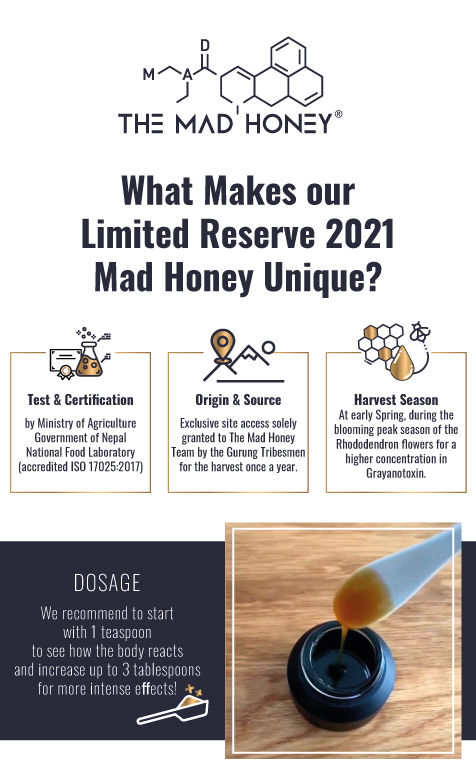- Mad Honey
- Aug 4, 2021
- 3 min read
To behold the Himalayan Apis Laboriosa foraging on the Rhododendron flowers and convert the collected nectar into Mad Honey is a one-of-a-kind experience. These highland bees possess genes that are perfectly compatible with the ‘invasive’ flowers which carry grayanotoxin.

The honey produced with grayanotoxin components is a precious nectar that is usually hard to find. And unless you are getting it from here, there is no guarantee that commercial mad honey is not over-processed or simply altered with cheaper kinds of honey.
According to the golden rule of sweetness, the value of honey can be deciphered by the following:
The overall quality ( raw, pure, or altered).
The region and climate in which the bees operate.
And the flora and fauna.
Lali Guransh, an Atypical National Flower
The story behind the production of mad honey is fascinating and unusual. Mad honey is not only about the bees, the honey hunters, but also much about the magic of the cosmos. The Rhododendron flower aka Lali Guransh, the national flower of Nepal largely contributes to the 'mad' properties of mad honey.
Rhododendrons are known for being noxious to humans, however, honey produced from the latter has psychoactive attributes and is largely used for its medicinal and recreational properties in Nepal.
Rhododendron stems are even used in dishes as the plant is believed to possess curative properties. The honey produced from the lali guransh is said to be effective in treating anxiety, insomnia, diabetes, and much more.
Grayanotoxins are toxins produced by rhododendrons and plants of the Ericaceae family. Ericaceaes consist of flowering plants that flourish in infertile growing conditions. This type of plant can be recognized by its leaves which are generally arranged along the stems; flowers usually grow in solitary or clusters with 5 petals, 5 sepals, and 10 stamens.
The Mad Honey Bees that Consume Grayanotoxin
Some types of rhododendron can contain up to 25 different types of grayanotoxin. The giant bees have become accustomed to the existing potent neurotoxin of the Lali Guransh and to them, it is merely a food source; the nectar is carried to the hive where potent mad honey is produced in oblivion.
Contrary to most bees who cannot ingest the rhododendron nectar, the Apis laboriosa has adapted to the highlands and has developed some sort of immunity to grayanotoxin. Hence, the bees are not intoxicated and neither are the humans who consume the Nepalese Mad Honey.
Rhododendron Luteum and Rhododendron Ponticum
The Rhododendrons are grown almost everywhere across the globe, however, it is essential that the giant Nepalese bees forage on the Rhododendron Luteum and Rhododendron Ponticum to produce what is known as mad honey.
The factor that primarily differentiates Nepalese mad honey from the Turkish lies in its conception - the rhododendron flowers flourish independently and are not cultivated in the Nepalese region as they are part of the scenery like the giant honey bees.
Seasons Influence the Potency of Mad Honey
The giant honey bees produce three types of honey; depending on the season, the level of grayanotoxin varies. The most potent form of honey is produced from the flowers at higher altitudes and is one of the rarest and most luxurious types of honey in the world. You can try it out here.
The honey that is harvested in autumn is cheaper since it is created from the Rhododendron present at all sites. This honey is more common and is sold at an average price. It is mainly harvested during late spring and autumn. It is renowned for its regenerative properties.
The most potent form of honey is produced from the Rhododendron flowers in Spring, at higher altitudes and is one of the rarest and most luxurious types of honey in the world.
The Mad Honey Limited Reserve
According to our customer reviews, The Mad Honey Limited Reserve, harvested in spring 2021, possesses a higher concentration of grayanotoxin leading to an elevated experience of the mad honey tasting.
Mad honey that is harvested in Autumn is cheaper since it is produced from the Rhododendron flowers present at all sites.
When it comes to the honey itself, the difference in taste can be as subtle as in the wine-tasting world. For instance, Manuka honey has a fuller consistency and an earthy, mineral-y taste whereas pure Himalayan mad honey has a slightly bitter aftertaste and has a more watery consistency which is why it spreads easily on the skin.
Depending on the harvest season, the potency of Mad Honey varies. See our FAQs to learn more.
If you’re fascinated by the lush scenery created by Rhododendron flowers, we recommend reading the following:
Note: We recommend experimenting with our two products, the Himalayan Mad Honey and the Limited Reserve 2021 Mad honey to assess both and appreciate your favorite.
































